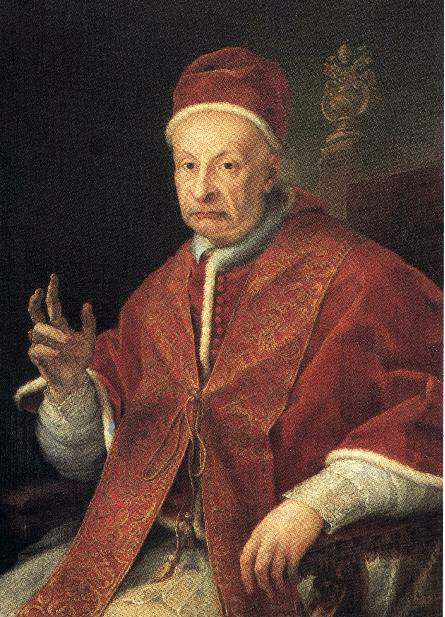of the Te Deum, below, are from
Te Deum laudámus:
te Dominum confitémur.
Te ætérnum Patrem
omnis terra venerátur.
Tibi omnes Angeli;
tibi cæli et univérsae potestátes.
Tibi Chérubim et Séraphim
incessábili voce proclámant:
Sanctus, Sanctus, Sanctus,
Dóminus Deus Sábaoth.
Pleni sunt cæli et terra
majestátis glóriæ tuæ.
Te gloriósus
Apostolórum chorus;
Te Prophetárum
laudábilis númerus;
Te Mártyrum
candidátus laudat exércitus.
Te per orbem terrárum
sancta confitétur Ecclésia:
Patrem
imménsæ majestátis;
Venerándum tuum verum
et únicum Fílium;
Sanctum quoque
Paráclitum Spíritum.
Tu Rex glóriæ,
Christe.
Tu Patris
sempitérnus es Fílius.
Tu ad liberándum susceptúrus hóminem,
non horruísti Vírginis úterum.
Tu, devícto mortis acúleo,
aperuísti credéntibus regna cælórum.
Tu ad déxteram Dei sedes,
in glória Patris.
Judex créderis
esse ventúrus.
Te ergo quǽsumus, tuis fámulis súbveni,
quos pretióso sánguine redemísti.
Ætérna fac cum sanctis tuis
in glória numerári.
[added later, mainly from Psalm verses:]
Salvum fac pópulum tuum, Dómine,
et bénedic hæreditáti tuæ.
Et rege eos,
et extólle illos usque in ætérnum.
Per síngulos dies
benedícimus te.
Et laudámus nomen tuum in sǽculum,
et in sǽculum sǽculi.
Dignáre, Dómine, die isto
sine peccáto nos custodíre.
Miserére nostri, Dómine,
miserére nostri.
Fiat misericórdia tua, Dómine, super nos,
quemádmodum sperávimus in te.
In te, Dómine, sperávi:
non confúndar in ætérnum.
O GOD, we praise Thee: we acknowledge Thee to be the Lord.
Everlasting Father, all the earth doth worship Thee.
To Thee all the Angels, the Heavens and all the Powers,
all the Cherubim and Seraphim, unceasingly proclaim:
Holy, Holy, Holy, Lord God of Hosts!
Heaven and earth are full of the Majesty of Thy glory.
The glorious choir of the Apostles,
the wonderful company of Prophets,
the white-robed army of Martyrs, praise Thee.
Holy Church throughout the world doth acknowledge Thee:
the Father of infinite Majesty;
Thy adorable, true and only Son;
and the Holy Spirit, the Comforter.
O Christ, Thou art the King of glory!
Thou art the everlasting Son of the Father.
Thou, having taken it upon Thyself to deliver man, didst not disdain the Virgin's womb.
Thou overcame the sting of death and hast opened to believers the Kingdom of Heaven.
Thou sitest at the right hand of God, in the glory of the Father.
We believe that Thou shalt come to be our Judge.
We beseech Thee, therefore, to help Thy servants
whom Thou hast redeemed with Thy Precious Blood.
Make them to be numbered with Thy Saints in everlasting glory.
V. Save Thy people, O Lord, and bless Thine inheritance!
R. Govern them, and raise them up forever.
V. Every day we thank Thee.
R. And we praise Thy Name forever, yea, forever and ever.
V. O Lord, deign to keep us from sin this day.
R. Have mercy on us, O Lord, have mercy on us.
V. Let Thy mercy, O Lord, be upon us, for we have hoped in Thee.
R. O Lord, in Thee I have hoped; let me never be put to shame.
"Te Deum laudamus",
Chorbogen, 1901.
(Wikimedia Commons)
Monks of one of the Abbeys of The Solesmes Congregation sing this beautiful Chant. The Te Deum is attributed to two Fathers and Doctors of The Church, Saint Ambrose and Saint Augustine and is one of the most majestic Chants in The Liturgy of The Church.
It is sung in Traditional Seminaries and Monastic Houses at The Divine Office and for Double Feasts of The First-Class, The Nativity, Easter, Corpus Christi, Epiphany, Pentecost and those Feasts which have an Octave. The Solemn Te Deum is sung on all occasions of public Church rejoicing (in Traditional Catholic Churches).

















.jpg)










